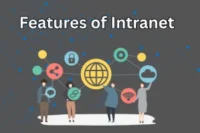What is an IP Address? Complete Guide
Published: 25 Sep 2025
Every device connected to the internet has a unique identifier called an IP address. Just like a postal address helps deliver mail to your home, an IP address ensures that data sent across the internet reaches the right device. Without IP addresses, your computer wouldn’t know how to connect to websites, send emails, or stream videos.
In this article, we’ll cover everything you need to know about IP addresses, including their types, how they work, the difference between IPv4 and IPv6, and why they matter for privacy, networking, and even SEO.
What Is an IP Address?
An IP address (Internet Protocol address) is a unique number assigned to each device that connects to a network using the Internet Protocol. It serves two main functions:
- Identification – every device has an IP to distinguish it from others.
- Location addressing – it shows where the device is on a network so that data can be routed to it.
Think of an IP address as the digital version of your home address. When you request a website, your IP tells the internet where to send the information.
Versions of IP: IPv4 vs IPv6
The following are the two main versions of IP addresses: IPv4 and IPv6.
IPv4 (Internet Protocol version 4)
IPv4 is the most widely used version of the Internet Protocol and forms the foundation of online communication. Its key features include:
- Format: Four sets of numbers separated by dots (e.g., 192.168.1.1).
- Size: 32-bit, which means around 4.3 billion unique addresses.
- Limitation: Due to the rapid growth of internet users and devices, IPv4 addresses are running out.
IPv6 (Internet Protocol version 6)
IPv6 was introduced to overcome the limitations of IPv4 and meet the demands of modern internet usage. Its main characteristics are:
- Format: Eight groups of hexadecimal numbers separated by colons (e.g., 2001:0db8:85a3::7334).
- Size: 128-bit, providing an almost unlimited number of addresses.
- Advantages: Improved efficiency, built-in security features, better support for IoT.
Coexistence: Today, both IPv4 and IPv6 run in parallel, with many networks supporting dual-stack (both protocols at once).
Types of IP Addresses
The following are the main types of IP addresses, each serving a different purpose in networking and communication.
Public vs Private IP Addresses
IP addresses can be categorized based on whether they are visible to the wider internet or limited to a local network:
- Public IP Address: Assigned by your Internet Service Provider (ISP). It is visible on the internet and unique globally.
- Private IP Address: Used within a local network (home, office). Not visible on the public internet. Typical ranges include 192.168.x.x and 10.x.x.x.
Static vs Dynamic IP Addresses
Another way to classify IP addresses is by whether they remain fixed or change over time:
- Static IP: Remains fixed, commonly used by servers, websites, or businesses needing consistent access.
- Dynamic IP: Changes periodically, usually assigned automatically by a router using DHCP. Most home users have dynamic IPs.
Special Types of IP
Apart from the standard categories, there are also special types of IP addresses designed for unique purposes:
- Loopback: 127.0.0.1 (used to test connections on your own device).
- Broadcast and Multicast: Used for sending data to multiple devices at once.
- Subnetting / CIDR: Breaks down networks for efficient management.
- APIPA (Automatic Private IP Addressing): Used when a device fails to get an IP from DHCP.
How IP Addresses Work
When you send or receive data online, the process looks like this:
- Your device creates data packets with your source IP and the destination IP (the website’s server).
- Routers along the way read the destination IP and forward the packet closer to its target.
- DNS (Domain Name System) translates human-friendly domain names (like google.com) into machine-friendly IP addresses.
- The server responds with the requested data, using your IP to know where to send it.
This seamless process happens in milliseconds, powering everything from browsing to streaming.
How to Find Your IP Address
Finding your IP address is simple, whether you want to check your public IP online or locate your private IP on your device. Knowing this can help with troubleshooting, network setup, and online security.
- Public IP: Visit sites like whatismyipaddress.com or search “What’s my IP” on Google.
- Private IP:
- Windows: ipconfig command in Command Prompt.
- Mac: System Preferences → Network → Advanced.
- Linux: ifconfig or ip addr.
- Mobile: Wi-Fi settings → Details.
- Advanced tools: traceroute, DNS lookup, Whois, and IP geolocation services.
What an IP Address Can Reveal
An IP address can reveal certain details about your connection, but it also has important limitations to keep in mind.
- ISP (Internet Service Provider).
- Approximate location (city or region).
- Network details like ASN (Autonomous System Number).
Limitations
- It cannot reveal your exact street address or personal identity.
- Accuracy of geolocation depends on databases used.
How to Hide or Mask Your IP Address
There are several ways to protect your IP and online privacy:
- VPN (Virtual Private Network): Encrypts your traffic and replaces your IP with one from the VPN server.
- Proxy Servers: Route requests through an intermediary server.
- Tor Network: Routes traffic across multiple servers for anonymity.
- NAT & Shared IPs: Multiple users sharing one public IP.
Each method has pros and cons in terms of speed, security, and reliability.
IP Address and SEO / Web Hosting
A common myth is that IP addresses directly impact SEO rankings. In reality:
- Shared vs Dedicated IPs: Google does not penalize websites sharing the same IP.
- SEO impact comes indirectly — issues like blacklisted IPs, downtime, or poor hosting can hurt rankings.
- CDNs (Content Delivery Networks): Improve speed by serving sites from multiple IPs worldwide, which benefits SEO indirectly.
Common Issues & Troubleshooting
Below are common issues related to IP addresses along with possible troubleshooting tips:
- IP Conflicts: Two devices on the same network with the same IP.
- Dynamic IP Changes: Causing connectivity or login issues.
- Blacklisted IPs: Often due to spam or abuse; can be resolved via ISP or blacklist removal.
The Future of IP Addresses
The future of IP addressing is evolving rapidly, with developments such as:
- IPv6 adoption is increasing to meet the needs of billions of IoT devices.
- Carrier-Grade NAT (CGNAT): ISPs use this to stretch IPv4 addresses further.
- Privacy regulations: In some regions, IP addresses are legally considered personal data.
- Decentralized networking: New technologies may reduce reliance on traditional IP systems.
Conclusion
So, in this article, we’ve covered What an IP Address is, its types, and why it matters in today’s digital world. An IP address is the backbone of internet communication; it identifies devices, enables data transfer, and plays a role in privacy, security, and hosting. Understanding the basics of IPv4 and IPv6, public vs private, and static vs dynamic IPs helps you take control of your online experience.
👉 Have questions? Share them in the comments. Let’s discuss how IP addresses impact your digital life.
Frequently Asked Questions (FAQs)
Here are answers to some of the most commonly asked questions about IP addresses. These will help you understand the basics and clear common doubts:
Your IP address can only reveal your ISP and approximate location, such as a city or region. It cannot show your exact home address or personal identity.
Most ISPs assign dynamic IPs that automatically change after a certain period or when you restart your router. This helps manage limited IPv4 addresses efficiently.
Yes, you can change it by restarting your router, using a VPN or proxy, or requesting a new one from your ISP. Some operating systems also allow manual configuration.
IPv4 uses a 32-bit address system, while IPv6 uses 128 bits, offering a much larger pool of addresses. IPv6 was introduced to solve IPv4 exhaustion and improve performance.
Public IPs are assigned by your ISP and are visible on the internet. Private IPs are used within local networks and cannot be accessed directly from outside.
In many regions, including the EU under GDPR, IP addresses are classified as personal data because they can be linked to a specific user or device.
Yes, inside a private network devices may share the same public IP through NAT. However, on the same network, duplicate private IPs can cause conflicts and connectivity issues.

- Be Respectful
- Stay Relevant
- Stay Positive
- True Feedback
- Encourage Discussion
- Avoid Spamming
- No Fake News
- Don't Copy-Paste
- No Personal Attacks

- Be Respectful
- Stay Relevant
- Stay Positive
- True Feedback
- Encourage Discussion
- Avoid Spamming
- No Fake News
- Don't Copy-Paste
- No Personal Attacks





